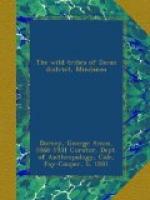The Bagobo is a keen trader and many small articles of all kinds reach, and pass from him through trade; and to make this barter possible he intentionally produces an excess of certain things. Chief of these is hemp, which he now carries to the coast traders, and for which he receives trade cloth, iron pots, copper gongs, bells, and the beads which he prizes so highly. In exchange for the betel boxes, bells, and knife guards, which come from his forge, he receives shell disks, certain articles of dress, cooking pots, and various other household articles as well as salt and some animals. The knives made by him are in great demand and often travel far inland. While among the Bukidnon of the North-Central part of the Island the writer secured one blade and guard of undoubted Bagobo workmanship. In early days, Chinese and Moro traders brought gongs, jars, plates, and other crockery, as well as many other articles now among the prized heirlooms of wealthy men or occupying an important place in the ceremonial life of the tribe. Through these same channels came the Borneo ivory of which the ear plugs are made, while other objects from more distant regions were occasionally brought in. Two examples of this trade are now in the collections of the Field Museum of Natural History. One is a jacket made from Javanese cloth; the second a belt buckle which apparently originated in Perak.
Local feuds, as well as the desire of individuals to be known as magani, have always made it unsafe for small numbers of traders to venture to any great distance from home, and this has been a great hindrance to trade. However, large parties, even from other tribes, sometimes go to a village for purposes of trade, having previously notified the inhabitants of their intentions. While in Malilla the writer met with a party of thirty Bila-an traders who lived three days’ march to the east. The influence of capture, intermarriage, and looting, in carrying the artifacts of one tribe into the territory of another has previously been mentioned.
WARFARE.
The offensive weapons used by the Bagobo are spears, knives (Fig. 15 and Plate XXXII), and at times bows and arrows (Fig. 17). For defense they carry shields, either round or oblong (Figs. 31-32), and cover the body with so many strips of hemp cloth that a knife thrust is warded off. Turning his body sideways to the enemy, the warrior crouches behind his shield, keeping up a continuous capering, rushing forward or dancing backward, seeking for an opening but seldom coming to close quarters. Arrows and spears are glanced off with the shield. An attack is usually initiated by the throwing of spears, then, if the enemy is at a disadvantage or confused, the warriors rush in to close combat. For this purpose they rely entirely on their knives, and as fencers they are unexcelled. They are but indifferent shots with the bow and arrow, and that weapon is but little used in actual combat. It has been frequently




